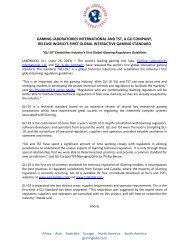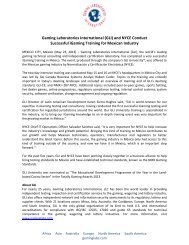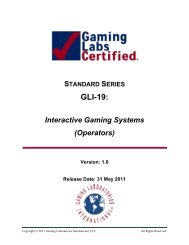GLI-19: - Gaming Laboratories International
GLI-19: - Gaming Laboratories International
GLI-19: - Gaming Laboratories International
Create successful ePaper yourself
Turn your PDF publications into a flip-book with our unique Google optimized e-Paper software.
<strong>GLI</strong> Standard #<strong>19</strong> – Standards for Interactive <strong>Gaming</strong> Systems (Suppliers) Version 1.0<br />
Final<br />
security domain shall be synchronized with an agreed accurate time source.<br />
7.3.11 Communications Security Management. This section refers to communications between<br />
the host <strong>Gaming</strong> Platform and an end player device, but it also applies to communications<br />
between other components or equipment of the <strong>Gaming</strong> Platform.<br />
a) Message authentication must be used with critical message types, such as jackpot wins<br />
and password/PIN transmissions, in order to verify the correct receipt of the message by<br />
the end player device, host or related equipment. A protocol that doesn’t correct errors or<br />
re-send erroneous packets (e.g. UDP) may be used as long as no critical game data or<br />
information is sent in this manner. For example, if UDP is being used to stream video or<br />
sound then it would not be acceptable to have the game instructions or paytable in this<br />
format only.<br />
b) The game server must be able to validate all of the information received from the client to<br />
ensure no additional data (such as a worm) has been sent.<br />
c) If it has been detected that additional data (such as a worm) has attached itself to the<br />
received data, the game server must not allow the extraneous byte code to pass through to<br />
the <strong>Gaming</strong> Platform.<br />
d) All protocols must use communication techniques which have proper error detection<br />
and/or recovery mechanisms and meet the following rules:<br />
i. The high level protocol must employ techniques (e.g. end to end<br />
acknowledgment) such that it will not lose messages – even when one end or the<br />
ii.<br />
other restarts;<br />
These techniques must not cause either the <strong>Gaming</strong> Platform or any end player<br />
device to completely halt all processes while waiting for this acknowledgement.<br />
e) The higher level protocol must employ techniques (e.g. transmission numbers) such that<br />
repeated messages are identified and discarded – even when one end or the other restarts;<br />
f) These requirements do not apply to unsecured messages such as broadcast messages;<br />
g) All functions of the protocol must be clearly specified in its documentation;<br />
h) The following rules apply to the timestamps in a high level protocol:<br />
i. It must include a provision for the transmitting system (i.e. <strong>Gaming</strong> Platform or<br />
end player device) to insert a local timestamp in every message it sends. This<br />
timestamp will assist in claims of equipment malfunction involving run away<br />
Chapter Seven: Information Systems Security (ISS) Requirements Page 59<br />
Copyright © 2011 <strong>Gaming</strong> <strong>Laboratories</strong> <strong>International</strong>, LLC<br />
All Rights Reserved.
















